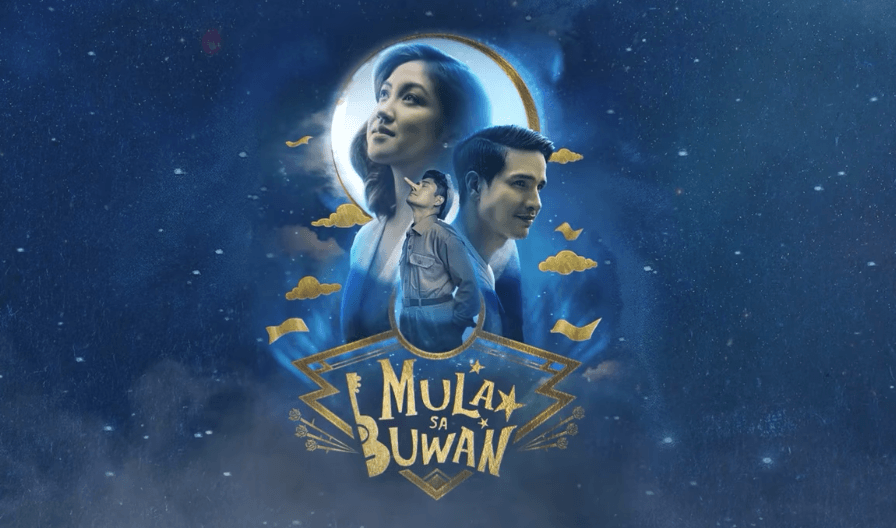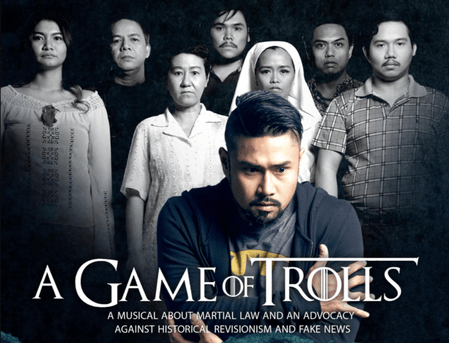SUMMARY
This is AI generated summarization, which may have errors. For context, always refer to the full article.

Spoilers ahead.
When Mula sa Buwan announced that it was being restaged, I was worried. Theaters are still struggling to retrofit, productions are still being shut down globally due to the pandemic, transportation is still stunted, and the economy is at a financial low point. One wonders: “Why restage Mula sa Buwan now?”
But after some thought, it makes sense. Mula sa Buwan rides the waves of two important cultural movements — the first being continuing deterioration of the country’s sociopolitical landscape that thrusts Filipinos into cynicism and despair; the second being the demand for wholesome and optimistic narratives that serve as an antidote to such a vapid culture. It is why the production, now on its fourth iteration in 12 years, has created so many devoted and protective fans — Mula Sa Buwan is, as aptly described by Apa Agbayani in 2018, “a brave reminder that dreaming has its place in times of turmoil.”
This restaging of Mula sa Buwan is the first time it is divorced from the university setting. The Samsung Performing Arts Center, located in Makati, is twice the size of Hyundai Hall in Arete and is distanced from the student audience responsible for catapulting it to cult status. With the safety net gone, director-playwright Pat Valera responds to this change in space by scaling up the production and rewriting the piece to be more reflective of the current times — aware that the world now is different from the world during its previous runs.
In those 12 years, Valera has described in interviews old and new how Mula sa Buwan‘s key asset is its youth. When Cyrano (Myke Salomon) helps a new cadet Christian (Markki Stroem) court his childhood friend Roxane (Gab Pangilinan), with whom the two of them are in love, one charges this martyrdom to inexperience. An ode to misfits, the musical leverages people like Cyrano — those who are pushed to the peripheries with how they look at life and how life looks at them. But in this restaging, Valera makes many directorial fumbles, most of which detract from the magic characteristic of the storytelling.
Valera makes his first and most crucial mistake by casting mostly veterans — their age immediately maturing their roles, making it difficult to suspend disbelief. Despite their able and well-sculpted bodies, the ensemble, save for a few notable exceptions, is a homogenous mass of actors. The rich inner life undoubtedly constructed by such talents is barely visible in their behaviors onstage, characters distinguished only by Bonsai Cielo’s stunning period costumes. Many of the actors — including the central trio — lose truth in their desire to fulfill this perceived requirement of magnitude, forgetting that there is power in smallness and in clear and purposeful gestures.
While the three leads have previously demonstrated their talents elsewhere, this restaging of Mula sa Buwan fails to maximize their potential. Markki Stroem — a walking wet dream — makes the mistake of confining Christian to the small corner of “stupid,” his judgment of his character making him an ineffective second lead, especially in the first act. While Gab Pangilinan’s singing is sonorous, there are moments when her acting — specifically during the musical’s most emotionally demanding scenes — fails to keep up with the power of her voice. While compelling and bursting with life, Myke Salomon seems miscast as Cyrano — his dashing looks and physical type not far enough from Stroem’s, requiring him to ham up his character to compensate.
Part of what is interesting about Mula sa Buwan is how disparate the first and second acts are — representative of the harsh coming-of-age during a period of immense violence, metaphorical for how difficult it is to believe in truth and suffering unless it’s experienced. In this restaging, Valera weaves in early signs of the imminent war to help thread the musical’s two acts together. Theater critic Arturo Hilado writes how Valera adds “tweaks in the script and staging [that] have provided subtexts cogent to the current political and social context.” But in doing so, Valera shatters the illusion too early for the audience and its characters, decreasing the impact of its violent opening number in the second act.
It doesn’t help that many of its technical and artistic elements fail to be synergistic. The sound at the Samsung Theater does a disservice to Salomon, who doubles as the production’s musical director, as many of the cast members struggle to be audible, leading to an imbalance in harmonies. Despite the extravagance of Ohm David’s set design, much of it fails to contribute to the storytelling — with the tall buildings and ladders serving more as a hazard to its actors as it wobbles incessantly throughout the run. JM Cabling’s choreography, while impressive, has hints of frustrating anachronism and borders on the excess, distracting from many of the musical’s most affective scenes.
Case in point: when Roxanne and Christian’s eyes meet for the first time, the image is supposed to be frozen — the gaze crucial in setting up the inevitable love triangle and the intrinsic pull that exists only between Roxane and Christian. Yet Valera has Christian move around immediately, marveling at the crowd instead of his would-be lover. Much of the blocking is difficult to comprehend, even with prior knowledge of the production, and knowing where to look isn’t made easier by Meliton Roxas’ lighting design, which fails to direct focus on the valuable, making key narrative images dispensable or emotionally weightless.
What is telling of the quality of this restaging are the conversations around it. Most publications and social media posts describe Mula sa Buwan either by reducing the musical into only a handful of elements like a checklist (as with Oliver Oliveros of BroadwayWorld.com), by overpraising it using unearned, sentimental platitudes (as with Nikki Francisco’s recent review on Theater Fans Manila), or simply using the adage “live theater is back” — the latter dismissive of smaller productions, regional work, and the most recent Virgin Labfest at CCP. The result is writing that is frankly insulting, treating the material and those involved in its creation without respect by failing to assess it for what it is.
It’s not as if there aren’t any magical moments in the restaging. When the Japanese flag replaces the inverted Philippine flag, one cannot help but feel a chill run up one’s spine. When Roxanne eulogizes her friends after the war, a funeral procession composed of silhouettes in the background accentuates her grief. When letters rain from the sky as Cyrano dies, a clear homage to Treb Monteras’ “Respeto,” one knows that these are all of the words left unsaid. When the image of the ghost light — the lone symbol of the persistence of theater around the world — bookends the musical, one cannot help but weep, understanding the struggle that theater practitioners have gone through in the last two years.
But theater is more than just a handful of moments, and it’s frustrating to see a production capable of greatness — as seen in earlier runs and within this run — fall short at every turn. – Rappler.com
Mula sa Buwan runs from August 26 to September 11, 2022 at the Samsung Performing Arts Theater. For ticket inquiries, you may check their website for more details.
Add a comment
How does this make you feel?


There are no comments yet. Add your comment to start the conversation.